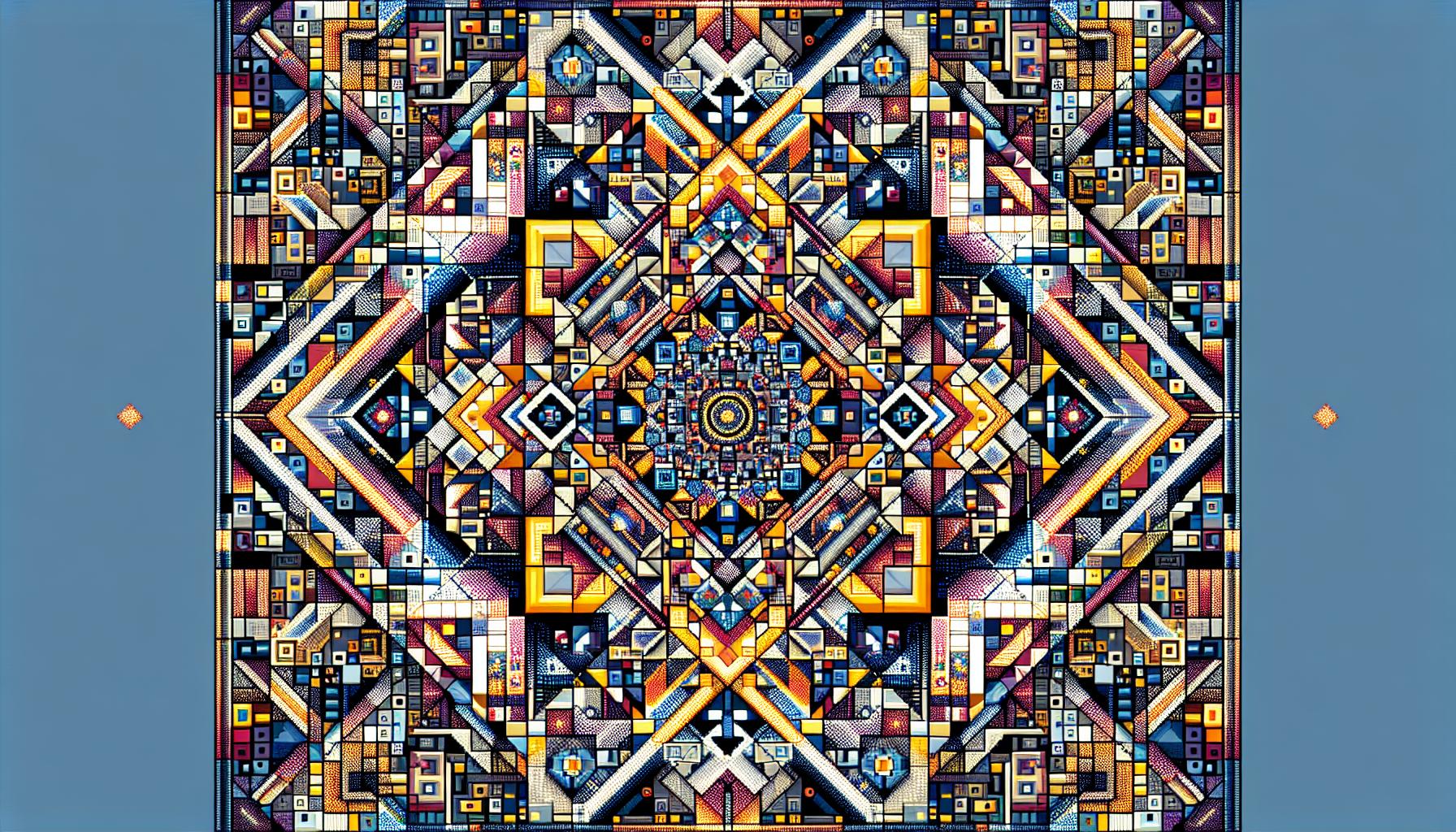Pixel art has experienced a remarkable renaissance in modern digital culture, transforming from humble 8-bit graphics into a beloved art form. With its distinctive blocky aesthetic and nostalgic charm, pixel art continues to captivate creators and audiences alike.
The unique identifier “facil:jzeh4ovueac=” represents a specific style within the pixel art community that’s gained traction among digital artists and game developers. This particular approach combines traditional pixel art techniques with modern design sensibilities, creating visually striking compositions that bridge the gap between retro and contemporary aesthetics.
Facil:jzeh4ovueac= Pixel Art
Facil:jzeh4ovueac= pixel art represents a specialized digital art style combining traditional pixel-based techniques with distinctive modern elements. This unique identifier denotes artwork created using precise pixel placement methods enhanced by mathematical algorithms that generate intricate patterns.
Key characteristics of facil:jzeh4ovueac= pixel art include:
- Limited color palettes containing 16-32 carefully selected hues
- Geometric pattern overlays that create depth perception
- Symmetrical composition structures across multiple axes
- Micro-detailing at 1-2 pixel scale intervals
- Angular gradient transitions between neighboring pixels
The artistic approach employs a grid-based system where each pixel coordinates with specific mathematical values. Artists utilizing this style maintain strict adherence to a 32×32 or 64×64 pixel canvas size, creating detailed compositions within these constraints.
Common subject matter includes:
- Abstract geometric landscapes
- Technology-inspired motifs
- Recursive pattern formations
- Architectural elements
- Crystalline structures
Technical specifications for facil:jzeh4ovueac= works:
| Feature | Specification |
|---|---|
| Canvas Size | 32×32 or 64×64 pixels |
| Color Depth | 4-5 bits per channel |
| Pattern Density | 8-12 pixels per unit |
| Edge Definition | Single pixel width |
| File Format | Lossless PNG |
This specialized form emerged from the intersection of traditional pixel art techniques modern computational design methods. Contemporary digital artists incorporate these elements to create visually complex pieces while maintaining the fundamental principles of pixel-based artwork.
Evolution of This Unique Art Style

The facil:jzeh4ovueac pixel art style emerged through distinct developmental phases, combining classic pixel art fundamentals with computational design principles. This evolution reflects both technological advancements and artistic innovation within the digital art community.
Early Origins and Influences
Pixel art originated in early video game graphics of the 1970s when technical limitations forced artists to work with individual pixels. Japanese developers pioneered essential techniques during the 1980s arcade era, creating sprites with limited 16-color palettes. The foundations of facil:jzeh4ovueac emerged in the late 1990s through demoscene artists experimenting with mathematical pattern generation. These artists integrated systematic grid layouts with traditional pixel-by-pixel placement, establishing core principles like symmetrical composition rules. Early practitioners developed specific methods for creating depth through layered geometric patterns, working within strict 32×32 pixel boundaries.
Modern Digital Adaptations
Contemporary facil:jzeh4ovueac artists leverage advanced software tools to enhance traditional pixel art techniques. Digital platforms enable precise color channel manipulation, resulting in sophisticated 4-5 bit gradients. Artists incorporate parametric pattern generators to create complex overlays while maintaining single-pixel precision. Modern implementations feature automated tools for edge detection, pattern density optimization, and color palette management. Software developments allow artists to maintain consistent 8-12 pixel unit densities across varying canvas sizes. Digital communities share specialized plug-ins, scripts, and workflows designed specifically for facil:jzeh4ovueac creation processes.
Key Features and Characteristics

Facil:jzeh4ovueac pixel art exhibits distinct visual elements that set it apart from traditional pixel art styles. These characteristics create a unique aesthetic that blends mathematical precision with artistic expression.
Color Palette and Composition
The color system employs restricted palettes ranging from 16 to 32 carefully selected hues, focusing on tonal relationships between adjacent pixels. Artists utilize geometric overlays to create depth perception through layered patterns at 45-degree angles. The composition follows strict symmetrical arrangements with central focal points radiating outward in regular intervals. Color transitions incorporate angular gradients at 2-pixel increments, creating smooth yet defined shifts between tones. Micro-details emerge through strategic placement of single pixels, forming intricate textures within larger geometric shapes.
Technical Specifications
The standard canvas dimensions include 32×32 pixels for icons or 64×64 pixels for detailed illustrations. Pattern density maintains 8-12 pixels per unit area, ensuring consistent visual weight across compositions. Each piece uses 4-5 bits per color channel, allowing for precise control over color depth while maintaining file efficiency. Edge definition adheres to single-pixel width guidelines, creating crisp boundaries between elements. Files export exclusively in lossless PNG format at 72 DPI resolution. The grid system enforces perfect alignment through snap-to-pixel positioning, eliminating anti-aliasing artifacts.
Creating Facil:jzeh4ovueac= Pixel Art

Facil:jzeh4ovueac= pixel art creation requires specific tools and methodical approaches to achieve its distinctive geometric patterns and limited color palettes. The process combines traditional pixel art techniques with modern computational methods to produce visually complex compositions within strict technical parameters.
Essential Tools and Software
Professional pixel artists use specialized software applications to create facil:jzeh4ovueac= artwork:
- Aseprite offers precise pixel-level control with custom grid settings for 32×32 or 64×64 canvases
- GraphicsGale provides advanced color manipulation tools for 4-5 bit channel depth management
- PyxelEdit features pattern generation capabilities for geometric overlay creation
- Pro Motion NG enables angular gradient transitions at 2-pixel increments
- Color palette managers maintain restricted sets of 16-32 hues
- PNG optimization tools preserve lossless quality at 72 DPI resolution
- Set up a 32×32 or 64×64 pixel canvas with grid overlay enabled
- Select 16-32 colors within the prescribed color depth parameters
- Create base shapes using single-pixel width lines
- Apply geometric patterns with 8-12 pixel density per unit
- Generate angular gradients at consistent 2-pixel intervals
- Add micro-details at 1-2 pixel scale
- Implement symmetrical composition with central focal points
- Layer pattern overlays for depth perception
- Validate color relationships between adjacent pixels
- Export as lossless PNG with precise grid alignment
Popular Applications and Uses
Facil:jzeh4ovueac pixel art finds extensive application across multiple digital platforms. Its distinct visual style creates immediate recognition through precise geometric patterns and limited color palettes.
Gaming and Entertainment
Game developers integrate facil:jzeh4ovueac pixel art in indie titles to create memorable user interfaces icons items character sprites. Mobile game studios leverage the style’s 32×32 pixel format for app icons buttons menu elements. Animation studios incorporate the angular gradient transitions into cutscenes intros title sequences. Streaming platforms display facil:jzeh4ovueac artwork as channel badges emotes subscriber rewards. Esports organizations utilize the symmetrical compositions for team logos tournament graphics promotional materials.
Digital Marketing
Marketing teams adopt facil:jzeh4ovueac pixel art for social media campaigns banner advertisements brand identities. Digital advertisers create eye catching 64×64 pixel animations for display networks retargeting ads. E-commerce platforms showcase product icons using the style’s restricted color palettes geometric overlays. Tech companies implement facil:jzeh4ovueac elements in corporate presentations infographics data visualizations. Social media influencers commission custom artwork for profile pictures thumbnails branded content.
| Application Type | Typical Canvas Size | Common Use Cases |
|---|---|---|
| Gaming Assets | 32×32 pixels | Icons, Sprites, UI Elements |
| Marketing Materials | 64×64 pixels | Ads, Logos, Animations |
| Social Media | Both sizes | Profile Pictures, Emotes |
Facil:jzeh4ovueac pixel art stands as a testament to the evolving landscape of digital creativity. This distinctive style bridges the gap between retro aesthetics and modern design principles through its precise technical specifications and methodical approach.
The fusion of mathematical precision systematic color selection and intricate pattern work has created a versatile art form that’s found its place in gaming marketing and digital media. As pixel art continues to thrive facil:jzeh4ovueac remains at the forefront of innovation pushing the boundaries of what’s possible within the constraints of pixel-based artwork.



